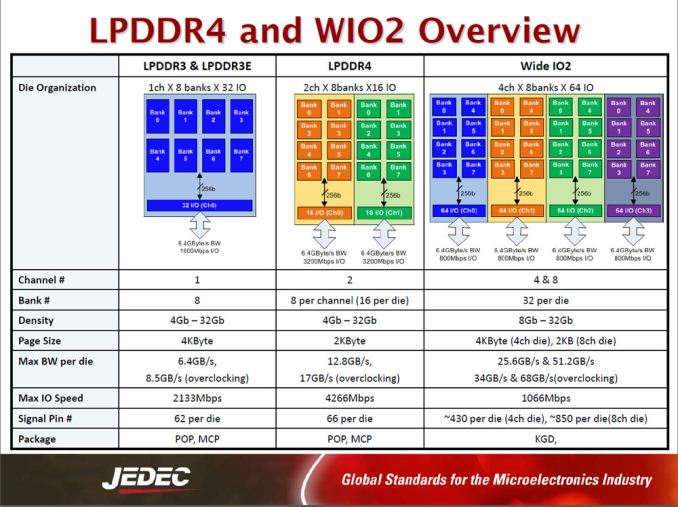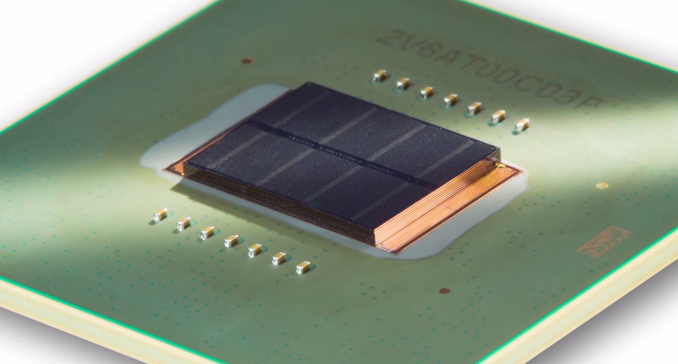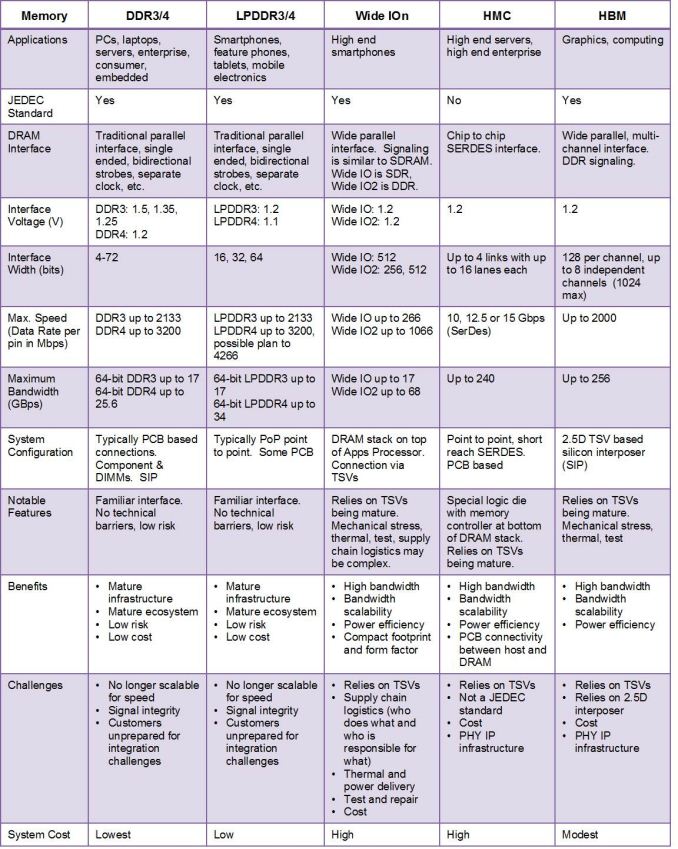DDR4 Haswell-E Scaling Review: 2133 to 3200 with G.Skill, Corsair, ADATA and Crucial
by Ian Cutress on February 5, 2015 10:10 AM ESTThe Future of DDR4
DDR4 was first launch in the enthusiast space for several reasons. On the server side, any opportunity to use lower power and drive cooling costs down is a positive, so aiming at Xeons and high-end consumer platforms was priority number one. Any of the big players in the datacenter space most likely had hardware in and running for several months before the consumer arms got hold of it. Being such a new element in the twisting dynamic of memory, the modules command a premium and the big purchasers got first pick. The downside of when that shifts to consumer where budgets are tighter and some of the intended benefits of DDR4 are not that important, such as lower power, it causes problems. When we first launched our Haswell-E piece, the cost of a 4x4GB kit of JEDEC DRAM for even a basic eight-core system was over $250, and not much has changed since. Memory companies have lower stock levels, driving up the cost, and will only make and sell more if people start buying them. At this point, Haswell-E and DDR4 is really restricted to early adopters or those with a professional requirement to go down this route.
DDR4 will start to get interesting when we see it in the mainstream consumer level. This means when regular Core i3/i5 desktops come into being, and eventually SO-DIMM variants in notebooks. The big question, as always, is when. If you believe the leaks, all arrows point towards a launch with Skylake on the Intel side, after Broadwell. Most analysts are also in this category, with the question being on how long the Broadwell platform on desktops is to last. The 14nm process node had plenty of issues, meaning that Q1 2015 is when we have started to see more Core-M (Broadwell-Y) products in notebooks and the launch of Broadwell-U, aiming at the AIO and mini-PC (such as the NUC and BRIX) market as well as laptops. This staggered launch would suggest that Broadwell on desktops should be due in the next few months, but there is no official indication as to when Skylake will hit the market, and in what form first. As always, Intel does not comment on unreleased product when asked.
On the AMD side of the equation, despite talks of a Kaveri refresh popping up in our forums and discussions about Carrizo focusing only on the sub-45W market with Excavator cores, we look to the talk surrounding Zen, K12 and everything that points to AMD’s architecture refresh with Jim Keller at the helm sometime around 2016. In a recent round table talk, Jim Keller described Zen as scaling from tablet to desktop but also probing servers. One would hope (as well as predict and imagine) that AMD is aiming for DDR4 with the platform. It makes sense to approach the memory subsystem of the new architecture from this angle, although for any official confirmation we might have to wait a few months at the earliest when AMD start releasing more information.
When DDR4 comes to desktop we will start to see a shift in the proportions of the market share that both DDR4 and DDR3 will get. The bulk memory market for desktop designs and mini-PCs will be a key demographic which will shift more to an equal DDR3-DDR4 stage and we can hope to achieve price parity before then. If we are to see mainstream DDR4 adoption, the bulk markets have to be interested in the performance of the platforms that require DDR4 specifically but also remain price competitive. It essentially means that companies like G.Skill that rely on DRAM sales for the bulk of their revenue have to make predictions on the performance of platforms like Skylake in order to tell their investors how quick DDR4 will take the market. It could be the difference between 10% and 33% adoption by the end of 2015.
One of the questions that sometimes appears with DDR4 is ‘what about DDR5?’. It looks like there are no plans to consider a DDR5 version ever for a number of reasons.
Firstly, but perhaps minor, is the nature of the DRAM interface. It relies on a parallel connection and if other standards are indicative of direction, it should probably be upgraded to a serial connection, similarly as how PCI/PCI Express and PATA/SATA has evolved in order to increase throughput while at the same time decreasing pin counts and being easier to design for the same bandwidth.
Secondly, and more importantly, are the other memory standards currently being explored in the research labs. Rather than attempt to copy verbatim a piece from ExtremeTech, I’ll summarize it here. The three standards of interest, whilst mostly mobile focused, are:
Wide I/O 2: Designed to be placed on top of processors directly, abusing a larger number of I/O pins by TSVs, keeping frequencies down in order to reduce heat generation. This has benefits in industries where space is at a premium, saving some PCB area in exchange for processor Z-height.
Hybrid Memory Cube (HMC): Similar to current monolithic DRAM dies but using a stacked slice over a logic base, allowing for much higher density and much higher bandwidth within a single module. This also increases energy efficiency, but introduces higher cost and requires higher power consumption per module.
High Bandwidth Memory (HBM): This is almost a combination of the two above, specifically aimed more at graphics by offering multiple DRAM dies stacked on or near the memory controller to increase density and bandwidth. It is more described as a specialized implementation of Wide I/O 2, but should afford up to a 256GB/s bandwidth on a 128-bit bus with 4-8 stacks on a single interface.
Image from ExtremeTech
Moving some of the memory power consumption onto the processor directly has thermal issues to consider, which means that memory bandwidth/cost might be improved at the expense of operating frequencies. Adding packages onto the processor also introduces a heavy element of cost, which might leave these specialist technologies to the super-early adopters to begin with.
Given the time from DDR4 being considered to it actually entering the desktop market, we can safely say that DDR4 will become the standard memory option over the next four years, just as DDR3 is right now. Beyond DDR4 is harder to predict, and depends on how Intel/AMD want to approach a solution that offers higher memory bandwidth, depending at what cost. Both companies will be looking at how their integrated graphics are performing, as that will ultimately be the best beneficiary to the design. AMD has some leverage in the discrete GPU space and will be able to transfer any knowledge used over to the CPU side, but Intel has a big wallet. Both Intel and AMD has experimented with eDRAM/SRAM as extra level caches with Crystal Well and PS4/XBone, which puts less stress on the external memory demands when it comes to processor graphics, which leads me to the prediction that DDR4 will be here in the market longer than DDR3 or DDR2.
If any of the major CPU/SoC manufacturers want to invest heavily in Wide I/O 2, HBM or HMC, we will have to wait. If it changes what we see on the desktop, the mini-PC or the laptop, we might have to wait even longer.













120 Comments
View All Comments
Dasa2 - Thursday, February 5, 2015 - link
To back up some of what i said here is a few linksI3 2100 matching 2500k@4ghz in dirt 3
http://www.tomshardware.com/reviews/gaming-fx-pent...
Arma a cpu bottlnecked game where a 2600k@4.3ghz with 2133c9 ram is faster than at 4.9ghz with 1600c11
http://forums.bistudio.com/showthread.php?166512-A...
Thief CPU|RAM performance
http://forums.atomicmpc.com.au/index.php/topic/557...
Bf4 1600c9=60fps 2400c10=70fps
http://www.team-greatbritain.com/call-of-duty-ghos...
Xbit ddr3 review looks a bit different to yours...
http://www.xbitlabs.com/articles/memory/display/ha...
Margalus - Friday, February 6, 2015 - link
And not one of those is using ddr4...Dasa2 - Friday, February 6, 2015 - link
Nope hence why I would like a decent review site like anandtech to do a proper job of there ddr4 reviewIm not expecting a big of a difference from higher speeds quad channel ddr4 by comparison to what can be seen in dual channel ddr3 but even there haswell ddr3 tests showed jack all due to the same problem with there tests so how can we know for sure
FlushedBubblyJock - Sunday, February 15, 2015 - link
You're correct, you made your points, so of course someone without many watts currently on display there said something silly, as usual being stupid pays off and those not dumbed down to base below average levels suffer the frustrating beyond belief consequences.mrcaffeinex - Friday, February 6, 2015 - link
The problem is that we currently do not have a non-enthusiast platform available that supports DDR4. The new X99 platform is also running quad-channel, so the best comparison to a prior platform would have to be using X79 (attempting to keep as close to apples to apples as possible). The point that can be taken from this article as it is right now, is that you can skip buying insanely-priced DDR4-3000+ memory because your X99 rig will probably not perform noticeably different with DDR4-2133.As the process matures and more systems adopt DDR4, then you'll be able to do a better comparison across multiple performance levels, but as it is right now, if you're buying into X99, you're buying a high-end CPU. I look forward to the extensive comparative tests that you have mentioned, but I do not see them happening until either the mainstream platform (LGA 115x) is running DDR4 or AMD has any offering that supports DDR4.
Dasa2 - Friday, February 6, 2015 - link
Unfortunately you cant take that from this article as the gaming tests wouldnt show if there was any gain from faster ram even if it did boost cpu performance by 15%These tests were worse than a complete waist of time from a gaming perspective as they could be very misleading
At a guess i would expect to see somewhere between 3-7% difference going from ddr4 2133 to ddr4 3200 at the same timings although most of that gain will probably be between 2133 and 2666 happy to be proven wrong though
Sushisamurai - Friday, February 6, 2015 - link
although I agree it would be nice to see the impact DDR4 timings and speeds on CPU bound games, I unfortunately don't see the real world application to it. With DDR4, we're working on Haswell-E, which already has a lot of compute power - if we were to run into any CPU bottlenecks, wouldn't it make more sense to spend more of the budget into the CPU instead of RAM? Unless, you had enough money to buy top CPU and top RAM, then the point becomes quite moot no?Dasa2 - Friday, February 6, 2015 - link
Depends how big the gain is from faster ram doesnt it and we wont know that until its tested properly with the ram speed compared cpu speeds toTesting cpu or ram performance with gpu bottleneck games is a waist of time unless your AMD trying to sell fx8150...
The only cpu limited games at this stage on Haswell-E will be the ones with bad multithreading support so spending a heap more on the cpu for extra cores from the 5960x wont help
What will help is spending extra for a better overclock and maybe faster ram but how far do you go
tim851 - Friday, February 6, 2015 - link
> The games you chose to review are so badly GPU bottlenecked its sad.That's why they were running these games at reduced resolutions and IQ settings, Einstein.
What game should Anandtech benchmark that is NOT GPU LIMITED - Quake 3 Arena?
Dasa2 - Friday, February 6, 2015 - link
They shouldnt reduce detail settings just no aa and resolution to 1080p while running a gtx980 or two (r9-290\gtx970\gtx780oc minimum)But with the likes of dirt 3 even if they do reduce detail settings its still gpu bottlnecked
Arma\Dayz are some of the only games that can be cpu bottlnecked with a single gtx770
Dying Light is very demanding on both cpu and gpu
http://translate.googleusercontent.com/translate_c...
There is a lot of games that can be a bit of a blend of cpu\gpu limitation with enough gpu power although most of these will run 60fps fine on a 5820k a fair few of them wont do 120-144fps
http://translate.google.com/translate?depth=6&...
As they are a blend there limitation can vary from one part of the game to the next for example testing BF4 SP although easier to get consistent results will be far more gpu limited than MP some levels will also be more gpu limited than others
This is why i suggest putting different models and clocks speeds of cpu in against ram speed results so that people can see where the limit really is and where money is best spent